The latest sales numbers saw a steady increase in demand for small cars and crossovers but there were a few anomalies. Based on the sales of the Ford Crown Victoria you might have thought it was the hottest new product on the market. Anything but. Long beyond its original life expectancy the Crown Vic – the Panther platform to Ford insiders – is finally headed for the automotive rust heap.
Within days, the last Panther will have rolled off the assembly line at Ford Motor Company’s St. Thomas, Ontario, assembly plant. Through the 27th of August, the plant had produced 60,376 Crown Victorias, 10,390 Lincoln Town Cars and 165 Mercury Grand Marquis since the first of January 2011.
Last week, the production count was 1,724 Crown Vic—all to fill police or taxi orders—and 280 Town Cars. Not bad for a dead, but not quite gone, and certainly venerable, automobile family.
Never heard of the Panther? That was the code name that Ford Engineering and Product Planning folks assigned to the all-new “down-sized big car” that went on sale in the fall of 1978 as a 1979 model. In those days, Ford gave names such as Panther, Fox and Wyoming to all-new designs under development. No one could have predicted then that the basic Panther design would endure through thick and thin for 33 years.
Even more remarkable is the internal consternation that surrounded Panther’s development.
The Seventies was a decade of uncertainty in Detroit. The decade started out traditionally, with ever bigger and more powerful American cars being absorbed by the public while imports such as VW (582,573 1970 US sales), Toyota (208,315 1970 US sales) and Datsun (155,000 1970 US sales) were growing fast but still trailed far behind.
A decade earlier, for 1960 models, the Big Three had brought out their first line of defense against the foreign car invasion—the so- called Compact cars. Now, to keep some skin in the game, Ford and GM were about to introduce for 1971 their first Sub-compacts, Ford Pinto and Chevrolet Vega. Chrysler hedged for 1971 with Plymouth- and Dodge-badged Sub-compact cars imported from overseas.
Still, Detroit’s successful mainstays consisted of two luxury cars, ten “full-sized” or “big” cars, an array of medium-sized cars, and carryovers of the compact cars including muscle and pony car variants. Ford had even downsized its compact cars, with the 103- inch wheelbase Maverick and Comet while Chevy and Pontiac held steady with 111-inch wheelbase Nova and Tempest.
Indeed, the big cars from the Big Three were big. The standard Chevrolets on a 119-inch wheelbase, offered in the four flavors of Biscayne, Bel Air, Impala and Caprice, were mostly powered with a 350-cid V8. GM produced a total of 816,000 1970-model full-sized Chevys, including only 27,800 with the base 250-cid Six. The “Big Ford” (Custom, Galaxie and LTD) was on a 121-inch wheelbase with a choice of two Sixes and eleven V8s ranging from 302- to 429-cid in size. Model Year 1970 Big Ford production volume came out almost identical to Chevy’s. And no one paid much attention to trucks except as workhorses.
At the top end, the Cadillac sedan’s standard engine was a 472-cid V8, mounted on either 129.5- or 133-inch wheelbase. Lincoln- Continental sedans enjoyed 460-cid V8 power on a 127-inch wheelbase. The whole industry was geared to these large cars and their big engines that were both standard at the top end and optional on muscular smaller cars.
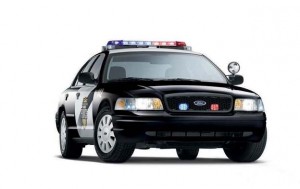
The Crown Vic, in its Interceptor package, has long been the car of choice for police departments in both the U.S. and Canada.
“Geared” meant from iron mines to assembly lines, Great Lakes ore boats, steel mills lining Detroit’s downriver frontage and segments of Lake Erie, and rail cars bulging with parts from suppliers all over the country’s center. And jobs, jobs, jobs. . .well-paying ones, with big raises every three years in renewed UAW contracts. The glory days, never to wane.
Automakers figured they had to offer a wide range of products to satisfy public tastes, no matter how irrational.
Except to a handful of elitist Eastern critics, those tastes didn’t seem so irrational with no-end-in-sight 30-cent-a-gallon gasoline. Jobs were plentiful, inflation negligible. Detroit was mostly uninvolved in the Vietnam War except for a few sons drafted or enlisted. The onset of Federal safety, bumper and pollution regulations were costly but absorbable in those high-volume, high-profit years.
Then the Arabs decided to attack Israel over the Jewish Yom Kippur holiday in September 1973—and got their ears pinned back for the effort. So the Arabs responded by embargoing oil shipments to the rest of the world. Fuel prices doubled, followed shortly by all energy costs. Car sales came squealing to a halt. Product planners didn’t know what to do. Because of long lead times, plans for 1975 and 1976 models were pretty well “baked in” by the start of 1974.
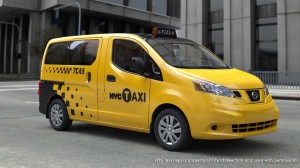
NY regulators recently approved a replacement for the Crown Vic, Nissan's Taxi of Tomorrow - a modified NV200.
But then, almost overnight again, about March of 1974, the gasoline supply crisis ended and motorists no longer had to line-up, hoping to fill-up before the pumps ran dry. Except the price didn’t roll back from the new normal, 60 cents per gallon.
In the meantime, Ford had introduced an all-new, full-size Big Ford on 121-in wheelbase for the 1973 model year, with the expectation its design would last for the conventional five years or more. Now planners did not know what to plan for, say, come 1977 or 1978 models. Bigger and thirstier or smaller and more fuel-efficient? No one could figure out which way the market would go. Months went by. Controversy and uncertainty raged within the Dearborn company.
Then word got around that General Motors was taking the big step of, first, downsizing its standard (i.e., “big”) Chevrolet, Pontiac, Oldsmobile, Buick and Cadillac for the 1977 model year and, second, their intermediate-sized cars for 1978. How should Ford meet this competitive challenge in the faraway largest segment of the market? Note that imported cars still were not part of this consideration: though far from competitive, Pinto, Vega and the 1976 Chevette had the import-fighter assignment.
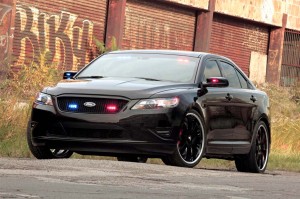
Ford hops to remain the supplier of choice for American police departments. This is one approach: the Ford Stealth Police Interceptor concept.
The big question boiled down to whether the fuel economy craze of 1973-74 was real, or just a flash in the pan. Ford already had a variety of car sizes, including a new body-on-frame 118-in wheelbase Ford Torino sedan for 1972 that some Ford planners hoped could replace the Big Ford—if only the public would accept the switch. But the public didn’t, they kept buying the Big Ford.
In this period of uncertainty, Ford virtually skipped–for all practical purposes–an entire model year, 1976, with no new car models of any size. A Ford vice president lost his job arguing with Henry Ford II, the company CEO, over which direction the company should go for its premier Big Ford product. He wanted to saw off the overhangs of the 1973-based car for downsizing whereas the big boss felt it should be an all-new car.
Needless to say, the man whose name was on the building won the argument. The result was the V-8 rear-wheel-drive, body-on-frame Panther, seven inches shorter than its predecessor. Its three-decade-plus longevity more than confirmed the Deuce’s judgment. No one, but no one, ever thought the Panther would last to more than a decade into the 21st century, in the process seeing its once huge “big car” market niche disappear.
Panthers for 1979 consisted of 114.4-in wheelbase Ford LTD/Crown Vic and Mercury Marquis/Grand Marquis. The 117.4-in-wheelbase Lincoln versions, Town Car and Continental, came the following year.
Originally Ford and Mercury Panthers were offered in three body styles, six-passenger four-door sedan, six- or eight-passenger four- door station wagon and six-passenger two-door coupe. There was no Lincoln station wagon. The two-door models disappeared after 1987 and the wagons after 1991.
Taxi operators and cops love the Crown Vic, and Limo operators the Town Car. As demonstrated by this year’s production reports, they’ve been buying up the cars for inventory. Crown Vic sales were limited by Ford a couple of years ago to just fleet delivery to taxi and police, but this year’s production has been roughly double that of the year before.
Panthers have proven to be not only reliable, but comfortable, quiet, solid, and a known quantity for maintenance and repair. When police Crown Vics get turned in after a hundred or two hundred-thousand hard miles, they are snapped up by taxi operators anywhere but where they are prohibited, in New York City and, as I recall, San Francisco. And after the taxi operators wring them out for another couple of hundred thousand, they migrate to the used market, often outside the US and Canada.
You are wondering where the “lead-sled” moniker came from. Over the 33 years, I’ve had four Panthers: 1979 Ford sedan, 1979 Mercury sedan, 1984 Ford Country Squire wagon and 1997 Town Car. The Country Squire migrated to my oldest daughter who drove it into the ground in rural western New York state and Minnesota. She fondly referred to it as her Lead Sled for its smooth, solid, level ride.

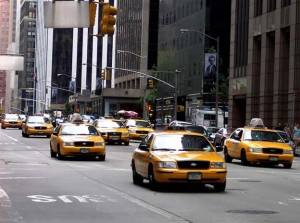
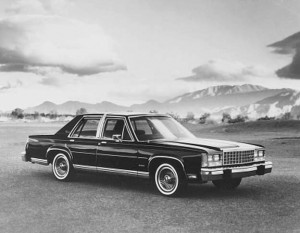
As long as you chose to picture the approved new Nissan New York taxi, you might have mentioned that the the more immediate successor to the Crown Vic on the Manhattan Streets is the Ford Transit Connect (since the Nissan vehicle will not exist for a couple of years).
True, Lee,
Thought the TC lost the battle and is a temporary fix, at best.
Me, I favored the weird little Turkish entry from the company nobody heard of.
Paul A. Eisenstein
Publisher, TheDetroitBureau.com